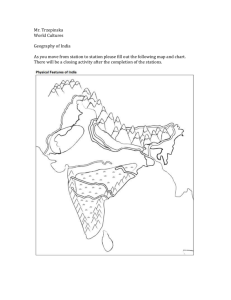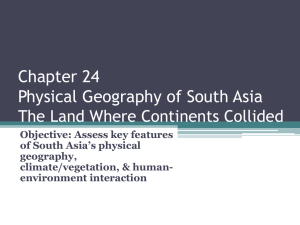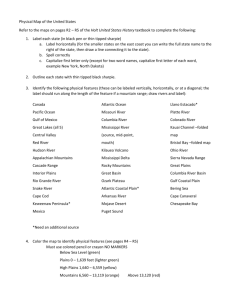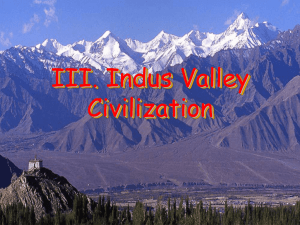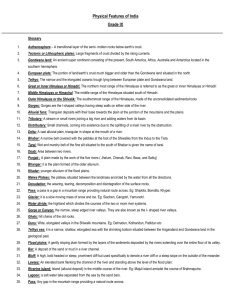Geography and the Early Settlement of India
advertisement
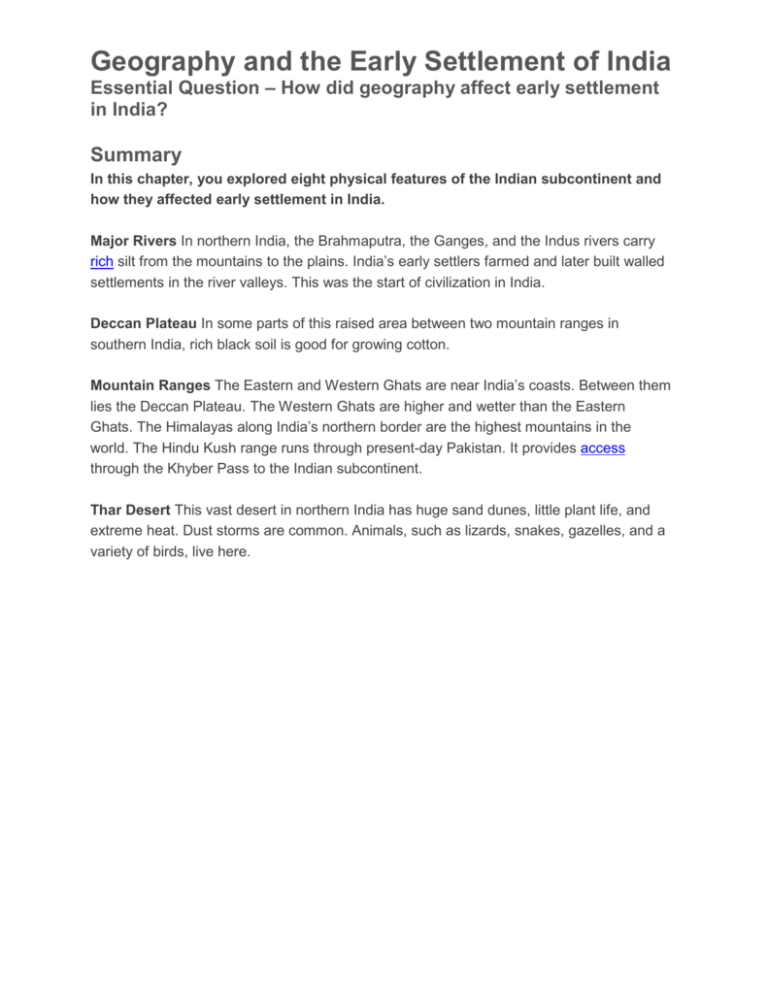
Geography and the Early Settlement of India Essential Question – How did geography affect early settlement in India? Summary In this chapter, you explored eight physical features of the Indian subcontinent and how they affected early settlement in India. Major Rivers In northern India, the Brahmaputra, the Ganges, and the Indus rivers carry rich silt from the mountains to the plains. India’s early settlers farmed and later built walled settlements in the river valleys. This was the start of civilization in India. Deccan Plateau In some parts of this raised area between two mountain ranges in southern India, rich black soil is good for growing cotton. Mountain Ranges The Eastern and Western Ghats are near India’s coasts. Between them lies the Deccan Plateau. The Western Ghats are higher and wetter than the Eastern Ghats. The Himalayas along India’s northern border are the highest mountains in the world. The Hindu Kush range runs through present-day Pakistan. It provides access through the Khyber Pass to the Indian subcontinent. Thar Desert This vast desert in northern India has huge sand dunes, little plant life, and extreme heat. Dust storms are common. Animals, such as lizards, snakes, gazelles, and a variety of birds, live here. Setting the Stage — Ancient India To the northeast of Africa lies the enormous continent of Asia. The south central part of Asia is known as the Indian subcontinent, which includes the country of India. Present-day India is a nation whose beginnings stretch back into the distant mists of time. When historians talk about ancient India, however, they are referring to the entire Indian subcontinent, not present-day India. Other present-day countries located on the Indian subcontinent include Bangladesh, Bhutan, Nepal, Pakistan, and the island nation of Sri Lanka. The ancient civilization that developed on the Indian subcontinent was greatly influenced by the physical geography of the region. Look at the map on the opposite page. Notice the Himalayan mountain range. These towering peaks are the highest mountains in the world. They formed a natural barrier between ancient India and the rest of Asia. To the south, the Arabian Sea, the Indian Ocean, and the Bay of Bengal prevented contact with other people. This isolation meant that civilizations developed on the Indian subcontinent without outside influences and had their own unique cultures. Look again at the map and find the Indus River. It begins high in the Himalayas and eventually empties into the Arabian Sea. Like other river valleys you have studied, the Indus River valley was the site of some early settlements, including Mohenjodaro and Harappa. Other rivers, like the Ganges and the Brahmaputra, also were home to early farming villages. These rivers provided the water and rich soil that allowed ancient cultures to grow and prosper. In time, two ancient empires arose in India. As the maps below show, the Mauryan Empire was the first to develop, and the Gupta Empire was the second. Two major religions have roots in ancient India. They are Hinduism and Buddhism. As you study this unit, you will learn about the development and beliefs of these two faiths. You will also study the achievements of the Mauryan and the Gupta empires. Section 1 — Introduction This stone sculpture represents Ganga, the goddess of the Ganges River. The Art Archive / Collection Antonovich / Gianni Dagli Orti In this unit, you will learn about the civilization of ancient India. First, in this chapter, you will explore the geography of the area, including its rivers, mountains, plains, plateaus, deserts, and valleys. These physical features influenced where ancient India’s civilization arose. Early towns began to appear in India in about 2500 B.C.E. Over the next 2,000 years, a unique civilization developed in India. According to an ancient Indian story, a river god and a river goddess once lived in the snowcovered Himalayas (him-uh-LAY-uhz), a mountain range extending through northern India. One day, the two decided to race down the mountains to the plains below. The river goddess sped straight down and won the race. But her joy soon turned to worry. Where was the river god? The river god had slowed down to admire the snowcapped mountains and the rich brown earth in the valleys. In time, he flowed down to meet his goddess. The two rivers became one, joined forever on India’s plains. The rivers made the land good for farming. In this chapter, you will learn about India’s rivers and other physical features. You’ll explore eight key features and their effects on the settlement of ancient India. Section 2 — Brahmaputra River A typical southern town along the Brahmaputra River gets between 70 and 150 inches of rain a year. The heaviest rainfall occurs during the southwest monsoon between June and October. Temperatures along the entire river may range from 45°F to 85°F. Robert Harding The land of India is a subcontinent of Asia. Looking at a map of Asia, you can see that India is attached to this continent. Many geographers call this part of Asia the Indian subcontinent. It is a large, triangular landmass that juts out from the southern part of Asia. Mountain ranges separate much of the Indian subcontinent from the rest of Asia. Our exploration of India begins with the Brahmaputra (brah-muh-POO-truh) River. This river runs through the steep Himalayas, the mountains along the northern border of India. From there, the Brahmaputra winds through snowcapped mountains and narrow canyons. The water is clear and cold as it rushes over the sharp rocks. The river becomes slower and deeper as it flows into its valley. Every summer, this part of the river receives added water from heavy monsoon rains. A monsoon is a strong wind that often brings huge amounts of rain. These rains can cause the river to overflow its banks. As the river recedes, the rich minerals that have been carried down from the Himalayas remain in the soil of the valley. Eventually, the Brahmaputra River joins another river, the Ganges (GAN-jeez), on the plains. The land where the two rivers meet is very fertile. Section 3 — Deccan Plateau A typical town in the Deccan Plateau receives about 30 inches of rain a year. The heaviest rainfall occurs between June and October, during the southwest monsoon. Temperatures on the plateau range from 65°F to 100°F. Robert Harding The Deccan (DEH-kuhn) Plateau is a triangle-shaped area that lies between two mountain ranges in southern India. Aplateau is an elevated, or raised, area of land that is flatter than a mountain. The Deccan Plateau has several kinds of land. In the flatter parts, large granite rocks formed by volcanoes cover the land. These rocks are among the world’s oldest, dating back more than six hundred million years. The hillier parts of the plateau have thin forests and low, scrubby bushes. The plateau is fairly dry. There are a few rivers, but the monsoon rains provide most of the water. The soil on the plateau is black, yellow, or red. The black soil is rich in iron and good for growing cotton. The yellow and red soils lack key minerals. This makes it harder for farmers to grow plants in those areas. Section 4 — Eastern and Western Ghats Parts of the Ghats receive 100 or more inches of rain a year. Temperatures range from 60°F to 90°F. R & S Michaud/Woodfin Camp & Assoc. The Eastern and Western Ghats (gahts) are long mountain chains near the coasts of India. The Eastern Ghats extend along India’s east coast. The Western Ghats extend along the west coast. When seen from above, the Ghats form a large “V.” The Deccan Plateau lies between these two mountain ranges. The Western Ghats are higher than the Eastern Ghats. The Western Ghats have steep slopes; narrow valleys; thick, hardwood forests; and extremely heavy rains. The wet climate encourages the growth of tropical plants. The Eastern Ghats are not as wet as the Western Ghats. Several rivers flow through these green mountains, which are dotted with hardwood trees. The rivers rarely flood, but they are unsafe for travel. They move rapidly, contain many rocks, and often plunge suddenly over cliffs. Section 5 — Ganges River Towns along the Ganges River receive 25 to 60 inches of rain a year. Temperatures in the Ganges plains range from 55°F to 90°F. Andrea Pistolesi-The Image Bank/Getty Images The Ganges River flows across most of northern India. It starts in the Himalaya Mountains. The river makes its way south through ice, rocks, and magnificent mountains and valleys. The river carries silt from the Himalayas to the northern plains. As the river passes through the plains, it leaves the rich sediment behind. As a result, the northern plains contain some of the most fertile farmland in the world. Melted ice carried down from the Himalayas provides the Ganges River plains with a good supply of water. During the rainy season, the river can flood and destroy crops planted along its banks. Section 6 — Himalaya Mountains The upper peaks of the Himalayas are always covered in snow and ice. The heaviest snowfall occurs between June and October, during the southwest monsoon. Temperatures on the highest peaks never rise above freezing (32°F) and can go as low as –76°F. Robert Harding The Himalaya Mountains are located along India’s northern border. This mountain range is the highest in the world. Mount Everest, the world’s tallest mountain, is part of the Himalayas. It reaches more than five and a half miles into the sky. The Himalayas form a natural border between the Indian subcontinent and most of the rest of Asia. The Himalayas live up to their name, which means “home of snows.” The highest peaks are always covered in snow and ice. Fierce storms can dump 10 feet of snow on the area at one time. Water from glaciers in the Himalaya Mountains feeds northern India’s major rivers. Underneath the Himalaya Mountains, the Earth is always moving. This movement causes Mount Everest to rise slightly every year. It also makes earthquakes and landslides common in the area. Section 7 — Hindu Kush Mountains The Hindu Kush mountain range receives about 15 inches of rain and snow a year. Weather and seasons vary greatly across the range. Temperatures in the Hindu Kush vary from about 25°F to 75°F. Robert Harding The Hindu Kush mountains form a rugged barrier between the Indus (INduhs) River valley and Afghanistan. This mountain range is not as tall as the Himalayas, but it is still one of the highest in the world. Some of its peaks are almost five miles high. Many parts of the mountain range are unlivable. Snow and ice permanently cover the steep slopes and peaks. The Khyber (KIE-ber) Pass forms a gap about 30 miles long in the mountains on the Afghanistan-Pakistan border. The pass connects central Asia to the Indian subcontinent. For thousands of years, traders used the pass to enter the Indus River valley. Invaders also used the pass. But many died in the mountains’ unforgiving landscape. Section 8 — Indus River Towns along the Indus River receive from 5 to 20 inches of rain a year. The heaviest rains fall between June and October, during the southwest monsoon. Temperatures in the Indus River valley range from 65°F to 90°F. John Elk III The Indus River begins in the Himalaya Mountains. It gets water from snow melting in the Hindu Kush mountains and other mountain ranges. This runoff of melting snow and ice from the mountains keeps the river’s water level high. Eventually, the river flows through present-day Pakistan and empties into the Arabian Sea. The Indus River valley contains some of the best farmland in the world. Like the Ganges River, the Indus River carries silt from the mountains to the plains. The silt leaves the surrounding soil rich and fertile. The Indus River has often been compared to Egypt’s Nile River. Like the Nile, the Indus is an important source of water for the farmland that lies along its banks. Section 9 — Thar Desert The Thar Desert receives about 4 to 20 inches of rain a year. The heaviest rains fall between June and October, during the southwest monsoon. Temperatures in the desert range from 45°F to 120°F. Carlos Freire/Hutchison Picture Library The massive Thar (tahr) Desert in northern India is mostly sand and stone. Huge, rolling sand dunes stretch for hundreds of miles. The landscape is littered with rocks. There is very little plant life except for grass and low, hardy shrubs. Most of the time, the heat is unbearable. Water is a very precious resource in the desert. Rain is rare, although the monsoons may occasionally bring a brief but intense storm. The dry conditions make dust storms common. Many animals and birds make their home in the desert. There are more than forty-five kinds of lizards and snakes. Gazelles lope across the sand. Birds include quail, ducks, and geese. Section 10 — Early Settlements in India The Indus and Ganges river valleys attracted the earliest settlements in ancient India. Here people found fertile soil and enough water. Like many ancient peoples, the first people in India most likely chose to settle near rivers. The rivers provided plenty of water. The fertile soil was ideal for farming. The rivers could also be used for travel and trade. The first known settlements in ancient India were in the Indus River valley. There were farming communities in this valley as early as 6500 B.C.E. By 5000 B.C.E., people also lived near the Ganges River. By 2500 B.C.E., there were walled settlements in the Indus River valley. The geography of India greatly influenced the location of early settlements on the subcontinent. Both the Indus and the Ganges rivers carried rich silt from the mountains to the plains. When the rivers flooded, the silt spread over the plains and made the soil in the river valleys fertile for farming. Over time, an ancient civilization developed and flourished in these settlements.
